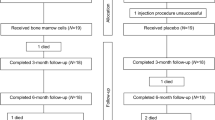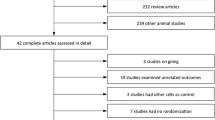Abstract
Introduction
Intracoronary infusion of bone marrow-derived progenitor cells (BMC) in patients with chronic ischaemic heart failure (CHF) is associated with improvement in left ventricular ejection fraction (LVEF), reduction of NT-proBNP levels and improved prognosis. However, effects of this therapy on cardiopulmonary exercise capacity have not been investigated separately so far.
Patients and methods
One hundred and fifty-four patients with ischaemic heart failure (mean LVEF 40.3 ± 10.9 %, NT-proBNP 1,103 ± 1,436 pg/ml) underwent cardiopulmonary exercise capacity testing (CPX) before and 3 months after intracoronary infusion of autologous BMC. Thirty patients with a potential bias on the CPX course as concomitant coronary intervention, bypass surgery, new onset of arrhythmias or implantation of cardiac resynchronization devices were excluded from further analysis.
Results
The remaining 124 patients showed an increase in exercise time and peak workload by 16.8 and 6 %. Peak oxygen uptake and oxygen uptake efficiency slope also improved by 2.9 and 12.9 %, whereas other parameters like peak oxygen pulse and the slope of minute ventilation versus CO2 elimination remained unchanged. Analysis of patients with poor, moderate and conserved CPX results prior to cell therapy documented that patients in tertiles with lowest initial exercise capacity showed the largest improvements in CPX after therapy. The differences in response to cell therapy were detectable in all investigated CPX parameters and became significant for exercise time, peak oxygen uptake and peak oxygen pulse.
Summary
These findings indicate that intracoronary BMC therapy improves exercise capacity in CHF patients with more advanced heart failure.

Similar content being viewed by others
References
Arena R, Myers J, Abella J et al (2010) Defining the optimal prognostic window for cardiopulmonary exercise testing in patients with heart failure. Circ Heart Fail 3:405–411
Arena R, Myers J, Guazzi M (2008) The clinical and research applications of aerobic capacity and ventilatory efficiency in heart failure: an evidence-based review. Heart Fail Rev 13:245–269
Assmus B, Fischer-Rasokat U, Honold J et al (2007) Transcoronary transplantation of functionally competent BMCs is associated with a decrease in natriuretic peptide serum levels and improved survival of patients with chronic postinfarction heart failure: results of the TOPCARE-CHD Registry. Circ Res 100:1234–1241
Assmus B, Honold J, Schachinger V et al (2006) Transcoronary transplantation of progenitor cells after myocardial infarction. N Engl J Med 355:1222–1232
Baba R, Nagashima M, Goto M et al (1996) Oxygen uptake efficiency slope: a new index of cardiorespiratory functional reserve derived from the relation between oxygen uptake and minute ventilation during incremental exercise. J Am Coll Cardiol 28:1567–1572
Balady GJ, Arena R, Sietsema K et al (2010) Clinician’s Guide to cardiopulmonary exercise testing in adults: a scientific statement from the American Heart Association. Circulation 122:191–225
Beaver WL, Wasserman K, Whipp BJ (1986) A new method for detecting anaerobic threshold by gas exchange. J Appl Physiol 60:2020–2027
Belardinelli R, Lacalaprice F, Carle F et al (2003) Exercise-induced myocardial ischaemia detected by cardiopulmonary exercise testing. Eur Heart J 24:1304–1313
Bristow MR, Saxon LA, Boehmer J et al (2004) Cardiac-resynchronization therapy with or without an implantable defibrillator in advanced chronic heart failure. N Engl J Med 350:2140–2150
Bruce RA, Blackmon JR, Jones JW et al (1963) Exercising testing in adult normal subjects and cardiac patients. Pediatrics 32(SUPPL):742–756
Erbs S, Linke A, Schachinger V et al (2007) Restoration of microvascular function in the infarct-related artery by intracoronary transplantation of bone marrow progenitor cells in patients with acute myocardial infarction: the Doppler Substudy of the reinfusion of enriched progenitor cells and infarct remodeling in acute myocardial infarction (REPAIR-AMI) trial. Circulation 116:366–374
Erbs S, Linke A, Schuler G et al (2006) Intracoronary administration of circulating blood-derived progenitor cells after recanalization of chronic coronary artery occlusion improves endothelial function. Circ Res 98:e48
Fischer-Rasokat U, Honold J, Seeger FH et al (2012) Early remodeling processes as predictors of diastolic function 5 years after reperfused acute myocardial infarction and intracoronary progenitor cell application. Clin Res Cardiol: Off J Ger Cardiac Soc 101:209–216
Fuchs S, Kornowski R, Weisz G et al (2006) Safety and feasibility of transendocardial autologous bone marrow cell transplantation in patients with advanced heart disease. Am J Cardiol 97:823–829
Grines CL, Topol EJ, Bates ER et al (1988) Infarct vessel status after intravenous tissue plasminogen activator and acute coronary angioplasty: prediction of clinical outcome. Am Heart J 115:1–7
Hjalmarson A, Goldstein S, Fagerberg B et al (2000) Effects of controlled-release metoprolol on total mortality, hospitalizations, and well-being in patients with heart failure: the Metoprolol CR/XL Randomized Intervention Trial in congestive heart failure (MERIT-HF). MERIT-HF Study Group. JAMA: J Am Med Assoc 283:1295–1302
Hollenberg M, Tager IB (2000) Oxygen uptake efficiency slope: an index of exercise performance and cardiopulmonary reserve requiring only submaximal exercise. J Am Coll Cardiol 36:194–201
Honold J, Derosa S, Spyridopoulos I et al (2013) Comparison of the seattle heart failure model and cardiopulmonary exercise capacity for prediction of death in patients with chronic ischemic heart failure and intracoronary progenitor cell application. Clin Cardiol 36:153–159
Honold J, Geiger L, Assmus B et al (2008) The initial slope of the VCO2/VO2-curve (s1) in cardiopulmonary exercise testing is a strong and independent predictor of outcome in patients with previous myocardial infarction. Clin Res Cardiol: Off J Ger Cardiac Soc 97:882–890
Ingle L, Goode K, Carroll S et al (2007) Prognostic value of the VE/VCO2 slope calculated from different time intervals in patients with suspected heart failure. Int J Cardiol 118:350–355
Jessup M, Brozena S (2003) Heart failure. N Engl J Med 348:2007–2018
Khand A, Gemmel I, Clark AL et al (2000) Is the prognosis of heart failure improving? J Am Coll Cardiol 36:2284–2286
Lavie CJ, Milani RV, Mehra MR (2004) Peak exercise oxygen pulse and prognosis in chronic heart failure. Am J Cardiol 93:588–593
Leistner DM, Fischer-Rasokat U, Honold J et al (2011) Transplantation of progenitor cells and regeneration enhancement in acute myocardial infarction (TOPCARE-AMI): final 5-year results suggest long-term safety and efficacy. Clin Res Cardiol: Off J Ger Cardiac Soc 100:925–934
Mancini DM, Eisen H, Kussmaul W et al (1991) Value of peak exercise oxygen consumption for optimal timing of cardiac transplantation in ambulatory patients with heart failure. Circulation 83:778–786
Moss AJ, Zareba W, Hall WJ et al (2002) Prophylactic implantation of a defibrillator in patients with myocardial infarction and reduced ejection fraction. N Engl J Med 346:877–883
Perin EC, Dohmann HF, Borojevic R et al (2003) Transendocardial, autologous bone marrow cell transplantation for severe, chronic ischemic heart failure. Circulation 107:2294–2302
Perin EC, Dohmann HF, Borojevic R et al (2004) Improved exercise capacity and ischemia 6 and 12 months after transendocardial injection of autologous bone marrow mononuclear cells for ischemic cardiomyopathy. Circulation 110:II213–II218
Perin EC, Silva GV, Henry TD et al. (2011) A randomized study of transendocardial injection of autologous bone marrow mononuclear cells and cell function analysis in ischemic heart failure (FOCUS-HF). Am Heart J 161:1078–1087 e1073
Pitt B, Williams G, Remme W et al (2001) The EPHESUS trial: eplerenone in patients with heart failure due to systolic dysfunction complicating acute myocardial infarction. Eplerenone Post-AMI Heart Failure Efficacy and Survival Study. Cardiovasc Drugs Ther/Spons by Int Soc Cardiovasc Pharmacother 15:79–87
Pokushalov E, Romanov A, Chernyavsky A et al (2010) Efficiency of intramyocardial injections of autologous bone marrow mononuclear cells in patients with ischemic heart failure: a randomized study. J Cardiovasc Transl Res 3:160–168
Roger VL, Go AS, Lloyd-Jones DM et al (2011) Heart disease and stroke statistics—2011 update: a report from the American Heart Association. Circulation 123:e18–e209
Schachinger V, Assmus B, Britten MB et al (2004) Transplantation of progenitor cells and regeneration enhancement in acute myocardial infarction: final one-year results of the TOPCARE-AMI Trial. J Am Coll Cardiol 44:1690–1699
Strauer BE, Yousef M, Schannwell CM (2010) The acute and long-term effects of intracoronary Stem cell Transplantation in 191 patients with chronic heARt failure: the STAR-heart study. Eur J Heart Fail 12:721–729
Strickberger SA, Conti J, Daoud EG et al (2005) Patient selection for cardiac resynchronization therapy: from the council on clinical cardiology subcommittee on electrocardiography and arrhythmias and the quality of care and outcomes research interdisciplinary working group, in collaboration with the heart rhythm society. Circulation 111:2146–2150
Van Laethem C, Bartunek J, Goethals M et al (2005) Oxygen uptake efficiency slope, a new submaximal parameter in evaluating exercise capacity in chronic heart failure patients. Am Heart J 149:175–180
Yusuf S, Sleight P, Pogue J et al (2000) Effects of an angiotensin-converting-enzyme inhibitor, ramipril, on cardiovascular events in high-risk patients. The heart outcomes prevention evaluation study investigators. N Engl J Med 342:145–153
Acknowledgments
We gratefully acknowledge the help and support of our study nurses Stephanie Estel, Daniela Hoehl and Isabel Geweyer.
Conflict of interest
Drs. Stefanie Dimmeler and Andreas Zeiher report that they are cofounders of t2cure, a for-profit company focused on regenerative therapies for cardiovascular disease. They serve as scientific advisers and are shareholders. There are no other conflicts of interest.
Author information
Authors and Affiliations
Corresponding author
Rights and permissions
About this article
Cite this article
Honold, J., Fischer-Rasokat, U., Seeger, F.H. et al. Impact of intracoronary reinfusion of bone marrow-derived mononuclear progenitor cells on cardiopulmonary exercise capacity in patients with chronic postinfarction heart failure. Clin Res Cardiol 102, 619–625 (2013). https://doi.org/10.1007/s00392-013-0574-1
Received:
Accepted:
Published:
Issue Date:
DOI: https://doi.org/10.1007/s00392-013-0574-1




